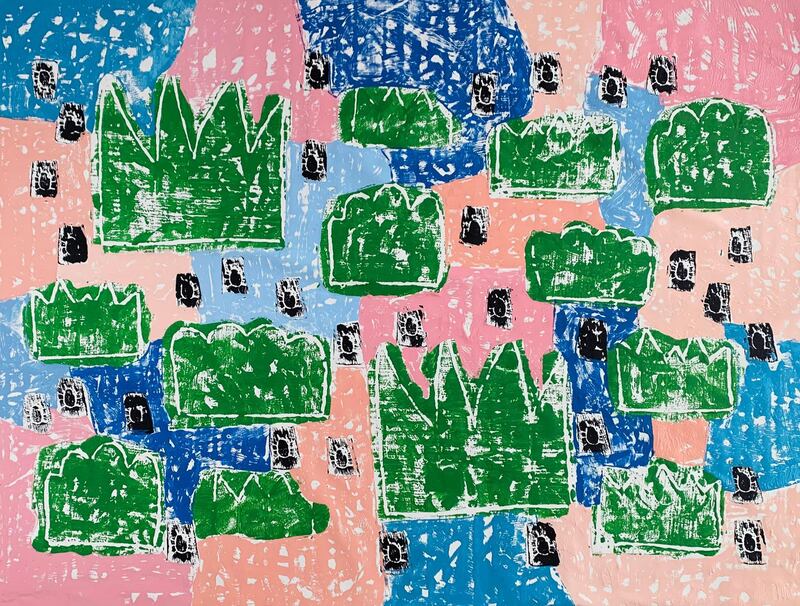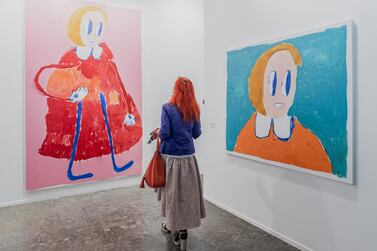The month of March promises to be busy for the UAE art scene. There's the return of Art Dubai, the emirate's international art fair that attracts thousands of visitors from around the world, plus Sharjah Art Foundation's March Meetings and upcoming major exhibition on art in the digital age, curated by Omar Kholeif. There will also be a series of gallery nights in Dubai, new exhibitions at Abu Dhabi's Warehouse 421, as well as the 10th anniversary of Sikka Art Festival.
But before all that kicks off, here are a few exhibitions to visit in the next two weeks before they end in time for the new art season.
Confessions of the Wait
In this minimalist yet compelling show, the works of Muzummil Ruheel contemplate the state of waiting. Shapes and sculptural letters are rearranged to convey the artist’s mental process (a double-ended arrow weaving itself into knots) and pauses of uncertainty (a cluster of alphabets hanging on strings). There are also his deceptively plain canvasses showing gold lines intersecting on a black background, with hidden written messages only visible up-close.
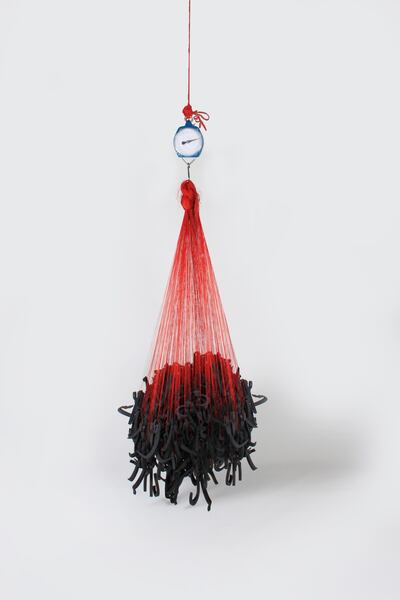
Ruheel’s training in Urdu, Persian and Arabic calligraphy are evident in these works, which play with written language as form and concept. His fascination with storytelling also drives his use of text, through which he espouses his political, social and personal views. In this exhibition at Dubai’s 1x1 Art Gallery, the works convey a sense of self-reflection and exploration of consciousness, while offering viewers a chance to appreciate the technical skill required to produce them.
On view at 1x1 Art Gallery until Saturday, February 29, 1x1artgallery.com
The Afflicted Yard
Peter Dean Rickards captured Jamaica in all its chaotic glory. Using a documentarian approach, he photographed gangsters, musicians, models and everyday people as they navigated the streets of the Caribbean nation. The selections of images at The Third Line highlight the diversity of Rickards’ archive, but also of his subject matter – the “yard”, a term for home in patois that Jamaicans use to refer to their country.
When Rickards started his career, Jamaica was undergoing economic and social problems, facing national debt and escalating murder rates. Instead of showcasing the touristic views of beaches and forests, he decided to focus on the underdog and the various characters that reflected the reality of the country, for better or worse.
Though the artist passed away in 2014, his website The Afflicted Yard, lives on. Rickards started the site as a way to showcase his photos, but also a blog where he could speak his mind on a various kinds of issues, including his dislike for Banksy. The British graffiti artist visited Jamaica in 2004 to create a variation of his work Balloon Girl on a wall. Years later, Rickards paid to have the wall removed and tried to sell it. When that failed, he exhibited it in a gallery to contrast how the artwork would be viewed by Jamaicans including himself ("who never saw the wall as a great piece of art") and "white people in the UK" as something they would "probably pay tremendous amounts of money for."
On view at The Third Line until Wednesday, March 4, thethirdline.com
Music of Letters: Bahman Panahi
With a style that he defines as “musicalligraphy”, Bahman Panahi fuses music and visual art to bring harmony to his canvasses. Trained in classical calligraphy under Iraninan masters such as Gholamhosein Amirkhani and Abdollah Foradi, Panahi is also a composer. During his days at Sorbonne University, he developed his doctoral research around the ‘musicality’ of letters, specifically in the context of calligraphy.
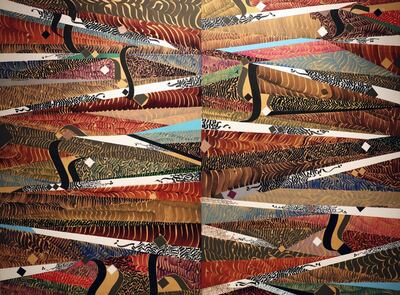
His works at Sharjah Calligraphy Museum, which have been developed over the last three years, typify his style. Letters become abstract forms, from sweeping curves to angular lines. His painting series demonstrate the range of Panahi's approach, which includes envisioning pieces as musical compositions – ochestras, duets or solos. In his Lines and Points, his strokes are dense, and the artist incorporates individual alphabetical elements such as the dot. His more complex compositions such as Carpet of Letters mimic the patterns of Persian carpets with their vibrant colours and intricate shapes. The show offers an enriching glimpse into the Islamic calligraphy, while illustrating its capacity to adapt and modernise with new forms.
On view at Sharjah Calligraphy Museum until Saturday, March 7, sharjahmuseums.ae
Qasida: Kamal Boullata
The late Palestinian artist and writer Kamal Boullata was a key figure in Modern Arab art, producing colourful works with elements of geometry and Arabic calligraphy. At Dubai's Meem Gallery, his final work – a silkscreen titled Qasida – is on view among other silkscreen prints dating back to the early 1980s. Created to support Palestinian human rights non-profit Al Shabaka, Qasida, the Arabic word for "poem" show a series of geometric units that bear the colour of the Palesitnian flag.
Through the works in the show, visitors can trace the shifts in Boullata’s practice, including his earlier preoccupations with letterism or the hurrufiya movement, defined by its borrowing elements of Islamic calligraphy and transforming them into modern, abstract forms. His works from the 1990s such as Three Quartets and Twelve Lanterns of Granada highlight his later style of repeating geometric forms.
Boullata, who passed away last year, was also an author and one of the first to write about Palestine’s art history. Meem Gallery will launch a collection of his essays titled There Where You Are Not as part of the exhibition. On February 29, Barjeel Art Foundation founder Sultan Sooud Al Qassemi will take part in a discussion about Boullata’s art practice and literary work.
On view at Meem Gallery until Sunday, March 9, meemgallery.com
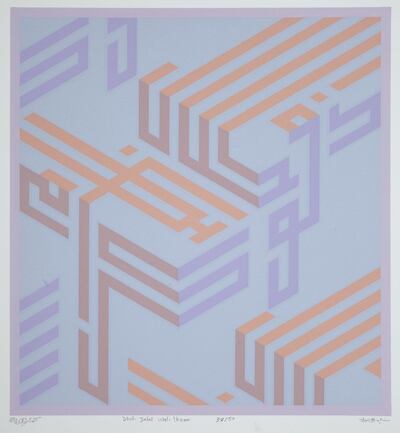
Nothing is Certain, Everything is Melting, and that’s Okay
In these surreal and perspective-bending paintings, British-Iraqi artist Athier departs from his usual use of geometric forms. Experimenting with more curved and fluid shapes, he draws subjects that appear to float in undetermined dimensions. His colours are more muted than usual, with various shapes of violets and purples that bring a dark mood to the pieces.
Walking the line between order and disorder, the artist combines disparate objects – marble blocks, rubble, plastic toys and foam – onto one canvas, and they all melt together in a varicoloured pool at the bottom. He also flips between the three-dimensional and two-dimensional as a way to challenge notions of perspective. For Athier, “there is no hierarchy of form”.
In these works, the artist, who was invited as visiting artist by the Palestinian Museum in 2014, derives influences from the Memphis movement of the 1980s, Italian surrealism and 3D computer graphics from the 1980s and 1990s. Created in his Paris studio, these works pull viewers into the artist’s dream-like world, where the natural order of things are slightly askew.
On view at Ayyam Gallery until Saturday, March 14, ayyamgallery.com
Towards Opacity
Featuring installations, photographs and paintings, Vikram Divecha's Towards Opacity at Gallery Isabelle van den Eynde considers systems of "capture and display", starting with the museum. The artist, who lived in Dubai before pursuing an MFA in Visual Art at Columbia University in the US, cites the beginnings of the exhibition during his frequent visits to the Metropolitan Museum of Art in New York. Specifically, the Gallery 354, which houses objects from the Oceanic region of Melanesia. Noticing how the hall was considerably darker than other exhibition spaces in the museum, Divecha was confronted with the subjectivity of visual perception.
Most of the works in the show try to unpack this experience, starting with an immersive installation resembling a photography darkroom where an audio recording of the artist's thoughts on Gallery 354 plays on a loop. In another installation titled The relationship between wood and sunlight, Divecha dives into ideas of museological display. Putting together discarded pieces from Columbia University's wood shop, he reconstructs a layout of the Met's gallery from memory. The pieces on the table are not secured, making the work seemingly precarious. For the artist, this presents an improvisational approach to display, which contrasts the rigid museological standards of archiving.
On view at Gallery IVDE until Saturday, March 14, ivde.net
Brainwashed by Nature: Olaf Breuning
For his third solo exhibition at Carbon 12, Olaf Breuning looks to nature, addressing the environmental issues confronted by the world today. Using woodcut slices to produce playful landscapes, the Swiss-born artist wishes to evoke a simpler method of production that challenges the more industrialised and technological-driven processes of making art. The choice of material is also significant to the concept of the show, as the artist deliberately draws from natural elements to give a voice to nature itself.
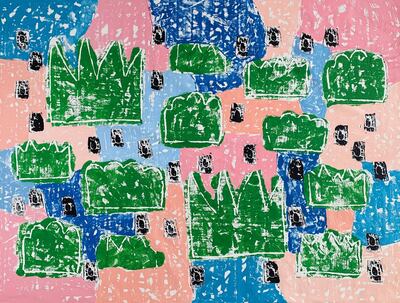
Breuning’s paintings travel from oceanscapes to valleys shadowed by dark clouds. His compositions can be interpreted in various ways. Initially, they may appear primitive and rough, but also exude a child-like way of viewing nature in vibrant and simplistic forms. At the same, these crude, patchy canvasses, borrowing the look of weather maps, can also be read as mirroring the turbulence of today’s climate patterns.
On view at Carbon 12 until Sunday, March 15, carbon12.art
